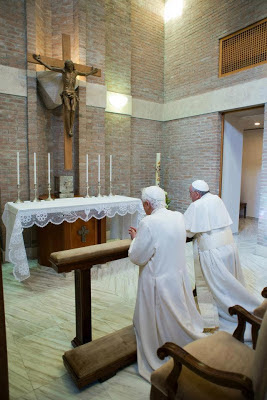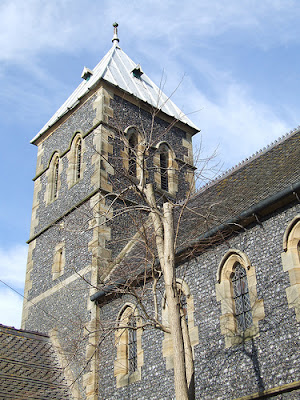It is often asserted that the question of the style of vestments (for example "Gothic" versus Baroque") is purely one of taste; that Baroque vestments represent an organic development of the Church’s liturgy and accordingly might not be questioned; and that the Traditions that people love should not be criticised. This presupposes that all "developments" are worthy.
It may be that whether one likes or dislikes Baroque vestments is a matter of taste. But the point of the
previous post was this: why is there an almost automatic association between Baroque vestments, lace albes etc. and the Extraordinary Form? The use of the word
Roman is avoided here to describe this style of vestment, because the High Baroque has no monopoly on the Tradition of vestments in Rome.
 |
| Pope Paul VI at his Coronation Mass, 1963. |
Unhappily, there is most certainly an attitude floating around in the circles of Catholic Tradition that this High Baroque expression of the Extraordinary Form is THE valid expression. Consequently (this is not a caricature of the view), using styles of vestments that are
older or
more modern than that of the High Baroque, is regarded with suspicion and even hostility. People should be aware that there are priests who refuse to wear more ample vestments because they regard them as antithetical to Tradition.
This is quite a disturbing attitude. It is an attitude that ought to be examined critically, because it is a very narrow interpretation of the concept of Tradition. It is not adequate to assert that the style of the High Baroque may not be subject to question because it is “Traditional”.
Exactly why is there such an attachment to this Baroque expression of Tradition? Perhaps this is a question which cuts to the heart of people’s perception of the nature of Tradition. It is a sociological issue also, which is certainly not the focus of this Blog. For many, what preceded the Second Vatican Council is
Traditional, what followed it is
not. This is also a view that ought to be examined critically, because it is a very narrow interpretation of the concept of Tradition.
Many people were greatly upset and even scandalised when Papal Rome made a wholesale rejection of the High Baroque in the late 1960’s. The array of Papal ceremonial was replaced with something very functional and austere: somewhat like the ethos of the 1960’s itself. Consequently, and for precisely this reason, there is a very negative attitude amongst some to modern expressions in the style of vestments. Had 1960’s Rome decided to use beautiful damasks for the Papal vestments instead of the plainest of silk, perhaps attitudes might have been different.
This issue has again come into focus with the expressed preference of Pope Francis to be vested in the plainest of vestments, which has been very off-putting to many people.

Perhaps those who were born after that the Second Vatican Council and whose experience of vestments has been the often uninspired, sometimes hideous products of the major Church suppliers find the beautiful damasks and ornamentation of the High Baroque chasuble quite attractive in their richness and in their differentness. There is also a certain fascination with this High Baroque style of vestment. And there is the concept that is once again becoming most important: using vestments of magnificence for the worship of God.
The photograph above shews the Benedictine Abbot of Le Barroux offering Mass in the Monastery church of
Sainte-Marie de la Garde (Saint Perre De Clairac, France) a foundation of Le Barroux. The vestments are very rich and, although obviously inspired by ancient forms, are nevertheless modern in presentation. They were made for and only used for the Extraordinary Form.


































